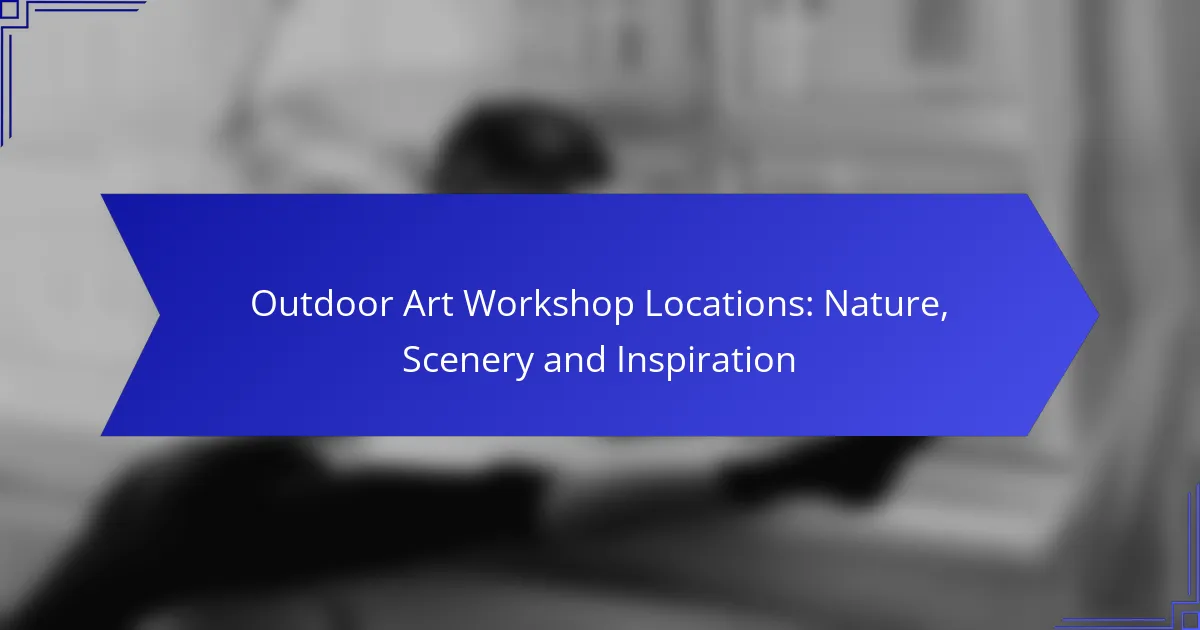Discover the best outdoor art workshop locations across the USA, where natural beauty serves as a backdrop for creativity. From serene national parks to vibrant urban spaces, each venue offers unique scenery that inspires artistic expression through various disciplines like painting, sculpture, and photography.

Where are the best outdoor art workshop locations in the USA?
The best outdoor art workshop locations in the USA include diverse settings that inspire creativity through natural beauty. From national parks to urban parks, each location offers unique scenery and opportunities for artistic expression.
National Parks
National parks provide stunning backdrops for outdoor art workshops, featuring breathtaking landscapes and rich ecosystems. Locations like Yosemite, Grand Canyon, and Yellowstone are popular choices, offering varied terrains that inspire different artistic styles.
When planning a workshop, consider the park’s regulations regarding permits and group sizes. Many parks require permits for organized activities, so check in advance to ensure compliance.
Botanical Gardens
Botanical gardens are excellent venues for outdoor art workshops, showcasing a wide variety of plant life and meticulously designed landscapes. These gardens often have designated areas for classes, making them convenient and visually appealing.
Look for gardens that offer educational programs or partnerships with local artists, as they may provide resources and support for your workshop. Admission fees can vary, so factor this into your budget.
Coastal Areas
Coastal areas, such as beaches and seaside cliffs, offer dynamic scenery for outdoor art workshops. The interplay of light, water, and land can inspire a range of artistic techniques, from painting to photography.
Be mindful of weather conditions and tides when planning your sessions. Early mornings or late afternoons often provide the best light for capturing coastal beauty.
Mountain Retreats
Mountain retreats provide a serene environment for outdoor art workshops, surrounded by majestic peaks and tranquil forests. Locations like the Rocky Mountains or the Appalachians offer both inspiration and solitude.
Consider accessibility and accommodation options for participants, especially if workshops span multiple days. Many retreats offer cabins or lodges, enhancing the overall experience.
Urban Parks
Urban parks can serve as vibrant settings for outdoor art workshops, blending nature with city life. Parks like Central Park in New York or Golden Gate Park in San Francisco provide iconic backdrops and ample space for creativity.
Check for any city regulations regarding public gatherings and permits. Urban parks often have facilities like restrooms and picnic areas, which can enhance the comfort of your workshop participants.

What types of outdoor art workshops are available?
Outdoor art workshops encompass a variety of creative disciplines, allowing participants to engage with nature while honing their artistic skills. These workshops typically include painting, sculpture, photography, and mixed media, each offering unique experiences and techniques.
Painting Workshops
Painting workshops often take place in scenic outdoor locations, providing artists with natural light and inspiring landscapes. Participants can explore various techniques, such as watercolor, acrylic, or oil painting, while learning from experienced instructors.
When choosing a painting workshop, consider the skill level required and the specific medium you wish to work with. Many workshops cater to beginners, while others may focus on advanced techniques.
Sculpture Workshops
Sculpture workshops allow artists to create three-dimensional works using materials like clay, wood, or metal. These sessions often emphasize the use of natural elements found in the surroundings, encouraging participants to incorporate local materials into their sculptures.
Look for workshops that offer guidance on different sculpting techniques and tools. Hands-on experience is crucial, so ensure the workshop includes ample time for practical application.
Photography Workshops
Photography workshops focus on capturing the beauty of outdoor settings through the lens. Participants learn about composition, lighting, and camera settings while exploring picturesque landscapes or urban environments.
Consider workshops that provide access to diverse locations and offer critiques on your work. It’s beneficial to have a basic understanding of photography concepts, but many workshops welcome all skill levels.
Mixed Media Workshops
Mixed media workshops encourage artists to combine various materials and techniques, such as painting, collage, and found objects. These workshops often promote experimentation and creativity, allowing participants to express their unique artistic voices.
When selecting a mixed media workshop, check if it includes a variety of materials and tools. This flexibility enables artists to explore different styles and methods in a supportive environment.

How to choose the right outdoor art workshop?
Choosing the right outdoor art workshop involves considering factors such as location, instructor expertise, duration, and materials provided. These elements can significantly impact your learning experience and overall satisfaction.
Consider Location
The location of an outdoor art workshop can greatly influence your inspiration and comfort. Look for settings that offer natural beauty, such as parks, gardens, or scenic viewpoints, which can enhance your creativity.
Additionally, consider accessibility. Workshops in urban areas may be easier to reach, while remote locations might provide a more immersive experience. Weigh the travel time against the potential benefits of the scenery.
Evaluate Instructor Expertise
Instructor expertise is crucial for a productive workshop. Research the background of potential instructors, including their artistic style, teaching experience, and previous workshop reviews.
Look for instructors who have a strong portfolio and positive feedback from past participants. A knowledgeable instructor can provide valuable insights and personalized guidance to help you develop your skills.
Assess Workshop Duration
The duration of the workshop can affect your learning outcomes. Short workshops, typically lasting a few hours, may focus on specific techniques, while longer sessions can offer in-depth exploration of various topics.
Consider your schedule and learning goals. If you prefer a quick introduction, a half-day workshop might suffice, but for comprehensive skill-building, look for multi-day options.
Review Materials Provided
Materials provided during the workshop can vary significantly. Some workshops include all necessary supplies, while others may require you to bring your own. Check the workshop details to understand what is included.
When materials are provided, ensure they are of good quality, as this can affect your experience. If you need to bring your own, confirm the specific items required to avoid surprises on the day of the workshop.

What are the benefits of outdoor art workshops?
Outdoor art workshops offer numerous benefits, including enhanced creativity, a deeper connection with nature, opportunities for social interaction, and skill development. These workshops provide a unique environment that fosters artistic expression and personal growth.
Enhanced Creativity
Participating in outdoor art workshops can significantly boost creativity by providing fresh inspiration from the surrounding environment. Natural light, diverse landscapes, and changing scenery stimulate the senses and encourage innovative thinking. Artists often find that the act of creating outdoors allows for more spontaneous and imaginative work.
To maximize creativity, choose locations that resonate with you, such as parks, beaches, or botanical gardens. Experiment with different mediums, like watercolors or pastels, that complement the outdoor setting.
Connection with Nature
Outdoor art workshops facilitate a profound connection with nature, allowing participants to immerse themselves in their surroundings. This connection can enhance mindfulness and promote well-being, as engaging with nature has been shown to reduce stress and improve mood.
Consider incorporating natural elements into your artwork, such as using leaves or flowers as inspiration. Take time to observe the details of your environment, which can lead to a more meaningful artistic experience.
Social Interaction
These workshops provide an excellent platform for social interaction, allowing artists to meet like-minded individuals and share ideas. Collaborating with others can lead to new friendships and creative partnerships, enriching the overall experience.
To foster social connections, participate in group projects or discussions during the workshop. Engaging in constructive feedback sessions can also enhance camaraderie and support among participants.
Skill Development
Outdoor art workshops are ideal for skill development, as they often feature guidance from experienced instructors. Participants can learn new techniques and receive personalized feedback in a supportive environment, which can accelerate their artistic growth.
When selecting a workshop, look for those that cater to your skill level and offer a variety of techniques. Regular practice in an outdoor setting can help solidify these skills, making it easier to apply them in future projects.

How to prepare for an outdoor art workshop?
Preparing for an outdoor art workshop involves selecting the right location, gathering supplies, and ensuring you are ready for various weather conditions. Proper preparation enhances creativity and allows you to focus on your art without distractions.
Gather Necessary Supplies
Start by compiling a list of essential art supplies tailored to your medium, whether it’s painting, drawing, or mixed media. Common items include sketchbooks, paints, brushes, palettes, and easels. Don’t forget to bring protective gear like aprons or gloves if needed.
Consider the outdoor setting when selecting your materials. For instance, if you plan to paint en plein air, choose portable supplies that are easy to transport. A lightweight easel and compact paint set can make a significant difference in your mobility and comfort.
Additionally, pack items that enhance your experience, such as water bottles, snacks, and a portable chair. A small first aid kit can also be useful in case of minor injuries. Always check the weather forecast and adjust your supplies accordingly, such as bringing sunblock or rain gear if necessary.
